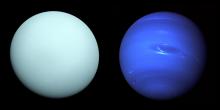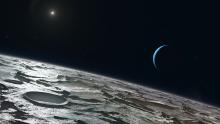Listen to today's episode of StarDate on the web the same day it airs in high-quality streaming audio without any extra ads or announcements. Choose a $8 one-month pass, or listen every day for a year for just $30.
You are here
Beyond Neptune
Objects that sound like exotic pizza ingredients sprinkle the realm beyond the planets: plutinos, twotinos, cubewanos, and many more — names that describe their orbits around the Sun.
Neptune is the most-distant major planet — almost three billion miles from the Sun. But astronomers have discovered almost 3,000 objects beyond Neptune. All of them are big balls or blocks of ice and rock.
The biggest and best known is Pluto. It’s about two-thirds the size of the Moon, and its lopsided orbit carries it well outside Neptune’s orbit. But the two orbits are related. The gravity of Neptune molds Pluto’s orbit, so Pluto completes two orbits around the Sun for every three that Neptune makes.
Quite a few other objects have similar relationships to Neptune. Since their orbits are like Pluto’s, they’re called “plutinos.”
Other objects have different relationships to Neptune. Some complete one orbit for every two that Neptune makes, for example, so they’re known as “twotinos.”
Some of the big iceballs aren’t controlled by Neptune’s gravity. The first to fit this category was 1992 QB1. The ones that followed are sometimes called “cubewanos” in its honor.
The farthest object yet seen is about 130 times farther than Earth is from the Sun. It’s informally known as FarFarOut; more about that tomorrow. The orbits of some other known objects, though, will carry them much farther — far into the deep freeze of the outer solar system.
Script by Damond Benningfield






